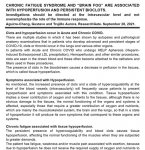- Messages
- 57
FIRST EVIDENCE PUBLISHED OF PERSISTENT CLOTS IN PATIENTS WITH CHRONIC COVID OR LONG COVID (see image).
http://www.sun.ac.za/english/Lists/news/DispForm.aspx?ID=8621
THIS IS A STUDY ALREADY PEER-REVIEWED.
These findings support the 6 steps to follow described in the “MANAGEMENT OF THE PATIENT WITH PERSISTENT SYMPTOMS OF COVID”:
https://www.researchgate.net/public...THE_PATIENT_WITH_PERSISTENT_SYMPTOMS_OF_COVID
And they support our Treatment Schemes that include Fibrinolytics, Anticoagulants and Antiplatelets.
Our indication is that all patients with Chronic Fatigue Syndrome (CFS) and/or Persistent COVID Symptoms should undergo a: VENOUS BLOOD GAS MEASUREMENT test, which is useful to know: VENOUS OXYGEN SATURATION (SvO2 or SatvO2). This will be reduced if there is a lower oxygen supply, the most frequent cause of this in Chronic COVID and CFS, the presence of persistent Bioclots.
As an aid to the diagnosis of persistent clots, the patient must also perform a D-dimer analysis (which may be within normal parameters or slightly elevated) and then the patient must follow the "Therapeutic Test" for the diagnosis of Infection. Persistent Viral. As this Test includes an antiplatelet such as Aspirin, and a diet high in Lysine, if at the end of this Test an increase in D-dimer is identified, this would indicate the presence of persistent Bioclots.
If there is dyspnea or a lot of fatigue, it is recommended to include in this Test 500 mg L-Lysine, which is sold without a prescription, as a nutritional supplement.
The drugs and doses of the "Therapeutic Test" are detailed in the document at the following link:
https://www.researchgate.net/public...SSIST_DIAGNOSIS_OF_PERSISTENT_VIRAL_INFECTION
Persistent Clots and hypercoagubility cause tissue Hypoperfusion and a decrease in Venous Oxygen Saturation (SvO2), and this causes the symptoms of Chronic Fatigue and Mental Fog:
https://www.researchgate.net/public...ED_WITH_HYPOPERFUSION_AND_PERSISTENT_BIOCLOTS
In women of childbearing age, the presence of persistent clots can cause decreased, absence or delay menstruation:
https://www.researchgate.net/public...IATED_WITH_THE_PRESENCE_OF_CLOTS_IN_THE_BLOOD
These persistent clots serve as a refuge and protection function for viruses and other intracellular microorganisms, in a similar way to how biofilms or biofilms do, which is why we have called them Bioclots:
https://www.researchgate.net/public...CROORGANISMS_USE_CLOTS_AS_A_REFUGE_TO_PERSIST
In a document from the end of 2020, we explained how several microorganisms that cause persistent intracellular infections use platelets and clots to persist, and we point out that the use of antiplatelets, fibrinolytics and anticoagulants is supported:
https://www.researchgate.net/public..._INCLUDING_SARS_CoV-2_INFECTION_AND_NEOPLASMS
http://www.sun.ac.za/english/Lists/news/DispForm.aspx?ID=8621
THIS IS A STUDY ALREADY PEER-REVIEWED.
These findings support the 6 steps to follow described in the “MANAGEMENT OF THE PATIENT WITH PERSISTENT SYMPTOMS OF COVID”:
https://www.researchgate.net/public...THE_PATIENT_WITH_PERSISTENT_SYMPTOMS_OF_COVID
And they support our Treatment Schemes that include Fibrinolytics, Anticoagulants and Antiplatelets.
Our indication is that all patients with Chronic Fatigue Syndrome (CFS) and/or Persistent COVID Symptoms should undergo a: VENOUS BLOOD GAS MEASUREMENT test, which is useful to know: VENOUS OXYGEN SATURATION (SvO2 or SatvO2). This will be reduced if there is a lower oxygen supply, the most frequent cause of this in Chronic COVID and CFS, the presence of persistent Bioclots.
As an aid to the diagnosis of persistent clots, the patient must also perform a D-dimer analysis (which may be within normal parameters or slightly elevated) and then the patient must follow the "Therapeutic Test" for the diagnosis of Infection. Persistent Viral. As this Test includes an antiplatelet such as Aspirin, and a diet high in Lysine, if at the end of this Test an increase in D-dimer is identified, this would indicate the presence of persistent Bioclots.
If there is dyspnea or a lot of fatigue, it is recommended to include in this Test 500 mg L-Lysine, which is sold without a prescription, as a nutritional supplement.
The drugs and doses of the "Therapeutic Test" are detailed in the document at the following link:
https://www.researchgate.net/public...SSIST_DIAGNOSIS_OF_PERSISTENT_VIRAL_INFECTION
Persistent Clots and hypercoagubility cause tissue Hypoperfusion and a decrease in Venous Oxygen Saturation (SvO2), and this causes the symptoms of Chronic Fatigue and Mental Fog:
https://www.researchgate.net/public...ED_WITH_HYPOPERFUSION_AND_PERSISTENT_BIOCLOTS
In women of childbearing age, the presence of persistent clots can cause decreased, absence or delay menstruation:
https://www.researchgate.net/public...IATED_WITH_THE_PRESENCE_OF_CLOTS_IN_THE_BLOOD
These persistent clots serve as a refuge and protection function for viruses and other intracellular microorganisms, in a similar way to how biofilms or biofilms do, which is why we have called them Bioclots:
https://www.researchgate.net/public...CROORGANISMS_USE_CLOTS_AS_A_REFUGE_TO_PERSIST
In a document from the end of 2020, we explained how several microorganisms that cause persistent intracellular infections use platelets and clots to persist, and we point out that the use of antiplatelets, fibrinolytics and anticoagulants is supported:
https://www.researchgate.net/public..._INCLUDING_SARS_CoV-2_INFECTION_AND_NEOPLASMS
Attachments
Last edited by a moderator:




